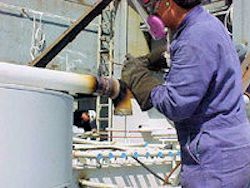Hand and Arm Protection
A variety of special clothing is available to protect the hands and arms during cutting and welding operations.
Welding Safety Guide
The protective clothing will vary with the size, location, and nature of the work performed.
Gauntlets and Gloves
During any welding or cutting operation, you should wear flameproof gloves with extended cuffs (gauntlets) to protect your hands and forearms.
- For gas welding and cutting, a five-finger style of flameproof gauntlet is generally used to allow better dexterity.
- For electric arc welding, a gauntlet-type mitt is recommended.
- Gauntlets protect the hands from both heat and metal spatter.
- The one-finger mitt designed for electric arc welding has an advantage over the glove because it reduces the danger of weld spatter and sparks lodging between the fingers. It also reduces the chafing of fingers, which sometimes occurs when using five-finger gloves for electric arc welding.
Choosing the proper clothing for welding and cutting is important for safety and comfort.

Protective Clothing
- Do not wear oilskins or plastic clothing during welding or cutting.
- If leather protective clothing is not available, wear woolen garments rather than cotton garments. Wool does not ignite as readily as cotton, and it affords greater protection from changes in temperature.
- Chemically treat cotton clothing, if necessary, to reduce its flammability. Do not wear synthetic fabrics.
Real-life Accident
A worker was using a plasma cutter, cutting notches in a piece of 3-inch by 6-inch (76 mm by 152 mm) steel tubing, when sparks and/or slag from the cut contacted his shirt.
The shirt, labeled 100 percent cotton, caught on fire and burned at a rapid pace consistent with that of clothing made from a synthetic material. He sustained second- and third-degree burns on the side of his abdomen and his left arm.
Knowledge Check Choose the best answer for the question.
6-3. If leather protective clothing is not available, what type of protective clothing should be worn because it doesn't catch fire readily?
You forgot to answer the question!
